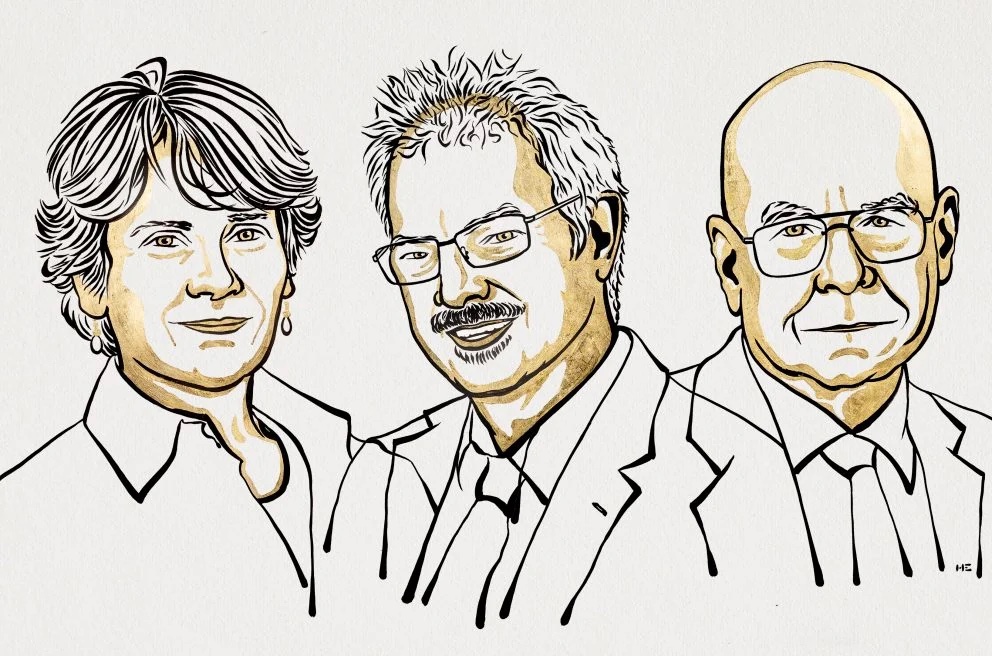Three molecule-building scientists win Nobel Prize in Chemistry
The “revolution” in chemistry has allowed for new ways to study disease and develop drugs
Madison Goldberg • October 5, 2022

Carolyn R. Bertozzi, Morten Meldal and K. Barry Sharpless, recipients of the 2022 Nobel Prize in Chemistry [Credit: Niklas Elmehed © Nobel Prize Outreach]
This year’s Nobel Prize in Chemistry went to three scientists who transformed the work of synthesizing large molecules.
K. Barry Sharpless and Morten Meldal shared the prize for developing the field of “click chemistry,” which creates complex molecules by snapping together smaller ones. The third awardee, Carolyn R. Bertozzi, brought the technique to living cells.
Bertozzi is the eighth woman to receive the chemistry prize since it was first awarded in 1901. Sharpless is the second person to win it twice.
The work of the laureates, who shared the prize equally, “has led to a revolution in how chemists think about linking molecules together” both in and out of living cells, said Johan Åqvist, chair of the Nobel Committee for Chemistry. The applications are far-ranging, he said — spanning polymer building, molecule tracking and drug delivery.
Before the advent of click chemistry, constructing big molecules was a finicky process, said Olof Ramström, a committee member. This process involved unpredictable chemical reactions that often created impure results. In a 2001 paper, Sharpless and his colleagues pointed out that some kinds of chemical bonds — though they occur naturally — are very tough for chemists to make in the lab.
Sharpless, who is at Scripps Research in California and also won his first prize for work related to chemical synthesis, described a much more efficient method. Instead of relying on those labor-intensive bonds, the researchers suggested searching for better-behaved compounds that like to fasten to one another. Attach those compounds to your building block molecules, and you can link them — like snapping together the ends of a buckle.
Meldal, of the University of Copenhagen, soon discovered a remarkably effective molecular buckle. The reaction he and his colleagues outlined (later separately described by Sharpless) clicked together two chemical clusters, called alkynes and azides. Adding copper ions to the mix, Ramström said, sped up the reaction and created a pure product.
The technique has been so useful for building complex molecules that it’s known as the “crown jewel of click reactions,” Ramström said.
Unfortunately, too much copper is toxic, meaning this reaction could be used in manufacturing but not in the human body. Making the alkyne-azide buckle safe for living cells — and leveraging the potential of click reactions for biology — was Bertozzi’s breakthrough.
Bertozzi, currently at Stanford University, had developed the concept of “bioorthogonal chemistry”: reactions that chug along in cells without affecting (or being affected by) them. In 2004, she and her colleagues presented a version of the alkyne-azide buckle that played well with cells. Using that reaction, Ramström said, researchers have been able to track chemical compounds and untangle their roles in disease.
For example, much of Bertozzi’s bioorthogonal research has involved a carbohydrate called a glycan. By snapping fluorescent green molecules onto glycans, scientists can track their movements. Her research has revealed that glycans act differently on normal cells and tumor cells, suggesting avenues for new cancer treatments.
“I think the field of bioorthogonal chemistry is still in its early phases,” Bertozzi said during a live phone call following the announcement. “There’s probably many new reactions to be discovered and invented,” with further applications for biotechnology and medicine.
She also emphasized the work done by the graduate students, post-doctoral fellows, and undergraduates in her lab. “It’s an opportunity for me to reflect on how fortunate I have been and to share in the celebration with them,” she said.